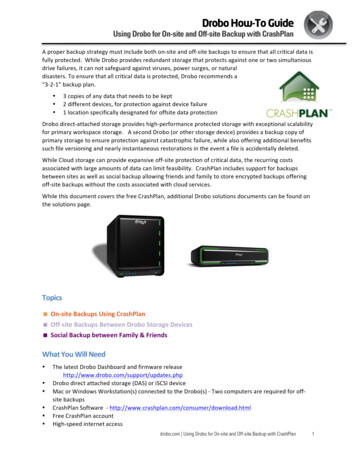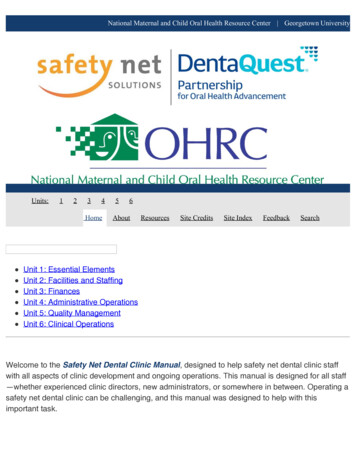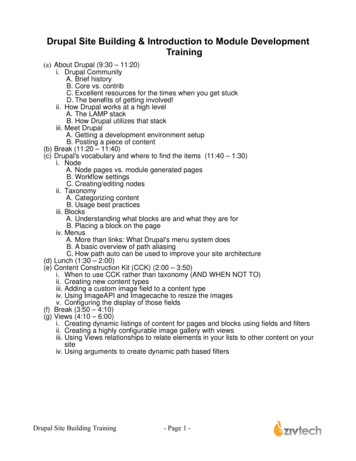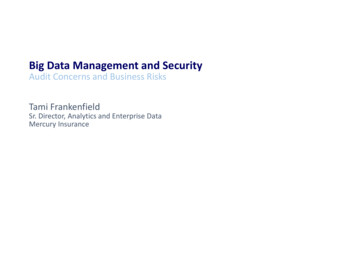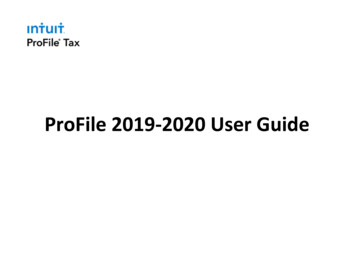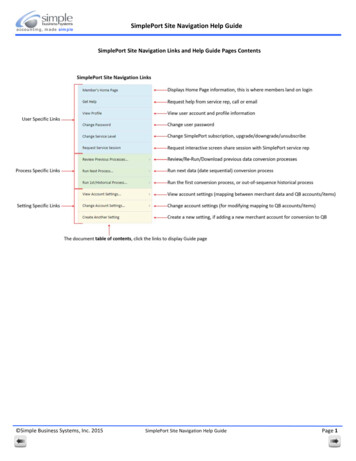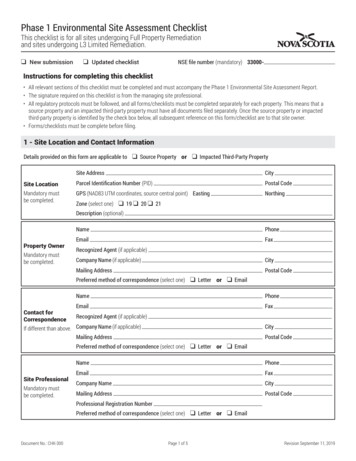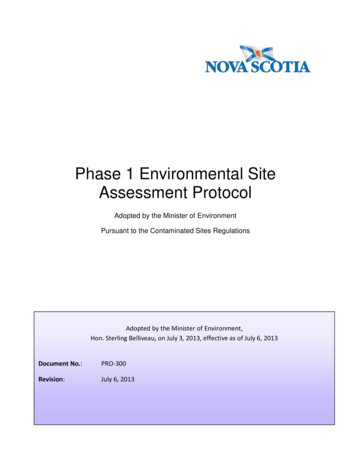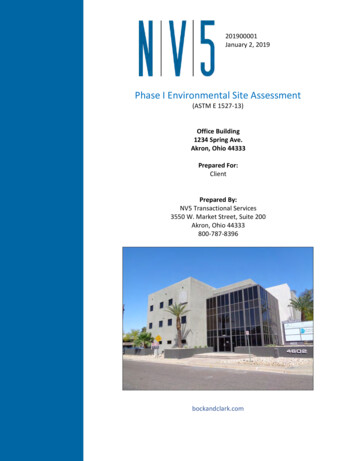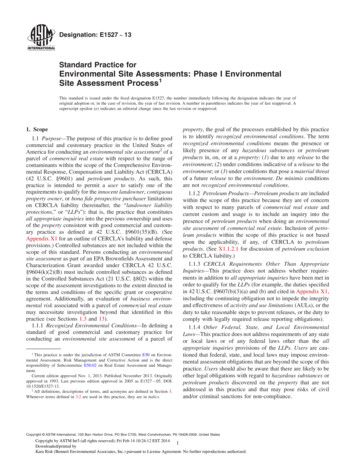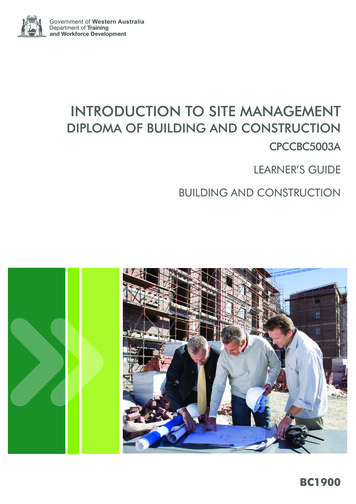
Transcription
INTRODUCTION TO SITE MANAGEMENTDIPLOMA OF BUILDING AND CONSTRUCTIONCPCCBC5003ALEARNER’S GUIDEBUILDING AND CONSTRUCTIONBC1900
Introduction to Site ManagementCPCCBC5003ALearner’s guide
Copyright and Terms of Use Department of Training and Workforce Development 2016 (unless indicatedotherwise, for example ‘Excluded Material’).The copyright material published in this product is subject to the Copyright Act 1968(Cth), and is owned by the Department of Training and Workforce Development or,where indicated, by a party other than the Department of Training and WorkforceDevelopment. The Department of Training and Workforce Development supportsand encourages use of its material for all legitimate purposes.Copyright material available on this website is licensed under a Creative CommonsAttribution 4.0 (CC BY 4.0) license unless indicated otherwise (Excluded Material).Except in relation to Excluded Material this license allows you to: Share — copy and redistribute the material in any medium or formatAdapt — remix, transform, and build upon the material for any purpose, evencommerciallyprovided you attribute the Department of Training and Workforce Development asthe source of the copyright material. The Department of Training and WorkforceDevelopment requests attribution as: Department of Training and WorkforceDevelopment (year of publication).Excluded Material not available under a Creative Commons license:1. The Department of Training and Workforce Development logo, other logos andtrademark protected material; and2. Material owned by third parties that has been reproduced with permission.Permission will need to be obtained from third parties to re-use their material.Excluded Material may not be licensed under a CC BY license and can only be usedin accordance with the specific terms of use attached to that material or wherepermitted by the Copyright Act 1968 (Cth). If you want to use such material in amanner that is not covered by those specific terms of use, you must requestpermission from the copyright owner of the material.If you have any questions regarding use of material available in this product, pleasecontact the Department of Training and Workforce Development.Training Sector ServicesTelephone: 08 6212 9789Email: sectorcapability.ip@dtwd.wa.gov.auWebsite: www.dtwd.wa.gov.au
First published 2012ISBN 978-1-74205-804-7 VET (WA) Ministerial Corporation 2012All rights reserved. No part of this publication may be reproduced, stored in a retrievalsystem or transmitted in any form or by any means, electronic, mechanical, photocopying,recording or otherwise, without the prior written permission of the Department of Trainingand Workforce Development.Whilst every effort has been made to ensure the accuracy of the information containedin this publication, no guarantee can be given that all errors and omissions have beenexcluded. No responsibility for loss occasioned to any person acting or refraining fromaction as a result of the material in this publication can be accepted by the Department ofTraining and Workforce Development.Published by and available fromDepartment of Training and Workforce Development1 Prospect Place West Perth WA 6005Tel: (08) 6212 9700 Fax: (08) 9227 8393Email: sales@dtwd.wa.gov.auWebsite: www.vetinfonet.dtwd.wa.gov.auThis product contains various images Thinkstock 2012, used under licence. Theseimages are protected by copyright law and are not to be reproduced or re-used in othermaterials without permission from the owner of Thinkstock.
Introduction to Site ManagementContentsIntroduction.7Chapter 1Management contracting.9Conventional contracts.9Management contracting.11Project management.12Construction management.18Conclusion.20Chapter 2Planning.21Introduction.21Purpose of planning.21Benefits of planning.22Planning in the building industry.22Basic steps in developing an overall plan.23Techniques of planning.23Characteristics of effective planning.24Obstacles to effective planning.24Unforeseen and unpredictable events.24Mental factors.25Policy planning.25Chapter 3Pre-tender planning.27Planning procedures.27Planning stages for project development.27Purpose of pre-tender planning.27The tender planning team.28Planning the tender.28Final decisions.40 VET (WA) Ministerial Corporation 2012BC19003
Chapter 4Pre‑contract planning.41Types of information.41Procedures.43Registration of drawings.43Further documentation.46Master construction program.49Other arrangements.51Site layout.51Chapter 5Project planning.57Site management structure.57Site organisation and administration.59Documentation.62Site instructions .68Variation orders.71Architect’s certificates.74Chapter 6Project control and reporting.79Subcontractor control.79Quality control.79Materials control.80Plant and equipment control (site).80Waste control.80Cost/budget control.80Progress control.84Conclusion.89Chapter 7Introduction to programming.93Introduction to critical path analysis/networks.93Types of network.94Advantages of network analysis.94Principles of programming.95Administering the network.964BC1900 VET (WA) Ministerial Corporation 2012
Introduction to Site ManagementChapter 8Introduction to arrow diagrams.99Network components.99Basic conventions and rules of logic.100Network preparation and management.106The critical path.109The node. 111Network computations. 111Summary.114Chapter 9Critical path networks.117Classes of float.118Preparing a network.121Chapter 10Critical path analysis.131Analysis sheet.131Preparing an analysis sheet.133Chapter 11Introduction to precedence diagrams.139Introduction.139Integral factors.142Relationships.145Conclusion.154Chapter 12Precedence networks.155Precedence – preparation and analysis.155Analysis involving lag.166Activity float.170Conclusion.171 VET (WA) Ministerial Corporation 2012BC19005
Chapter 13Gantt chart (or bar chart or time and progress schedule).173Introduction.173Comparisons – networks and Gantt charts.174Procedure for preparing Gantt charts.176Determining the critical path.183Float.185Conclusion.185Chapter 14Resources.187Introduction.187Resource
project management . and. construction management – and how they differ from the ‘traditional’ contractual arrangement. Consideration of practical on-site management includes site assessment and layout, site mobilisation and on-site administration and control. Finally, this resource presents an introduction to, and overview of, critical path network planning, whose principles form the .

